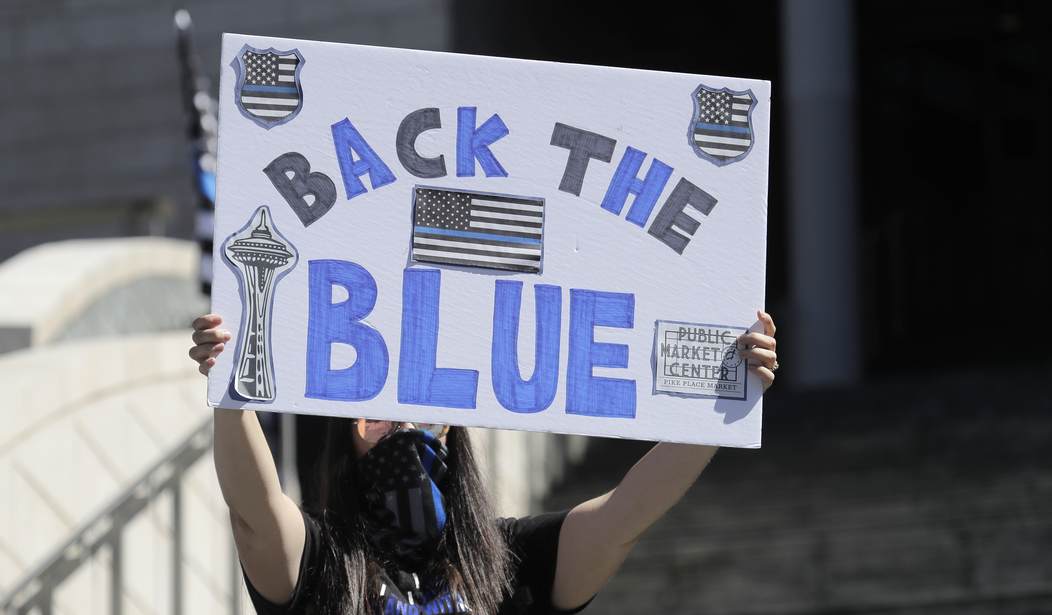You probably remember the Capitol Hill Autonomous Zone (CHAZ) which was formed in Seattle back in 2020 before it was renamed the Capitol Hill Occupied Protest (CHOP). The CHAZ/CHOP was supposed to be a living example of how woke anarchists could create a utopia by simply removing the fascist element (Seattle PD) from the a few square blocks.
Initially, the police chief and the city complied, pulling out of the precinct and effectively leaving a few square blocks of the city with no law enforcement. CHAZ residents came up with a list of demands which included a 50% cut to the police budget. Seattle Mayor Jenny Durkan famously described CHAZ as having a “block party atmosphere.” Seattle’s socialist city council member Kshama Sawant visited and urged the residents to turn the area into a restorative justice center. Vox, among other left wing outlets, wrote about the CHAZ as a blossoming communist paradise.
CHAZ has since evolved further into a center of peaceful protest, free political speech, co-ops, and community gardens. Protesters have invited the city’s houseless population, who had been subject to a mass “clearing” of tent communities throughout the city, to come stay in the neighborhood. Movie nights have been held, including Mississippi Burning, about two FBI agents investigating lynchings of black people and activists in Mississippi during the civil rights era.
“There was an impromptu dodgeball game,” said Carla. “There are people smoking weed in circles … and just having normal conversations, and then 20 feet away, you have this large group of people standing around somebody with a megaphone talking about Marxism.”
The zone, where hundreds of people can be found on any given day, is largely leaderless, with decisions often being made by vote. But volunteers have stepped in anyway, doing everything from distributing food to cleaning up garbage in the area. The vibe there is pretty relaxed, said Carla…
Yet right-wing media has painted CHAZ as some kind of war zone, portraying the tiny neighborhood as if it were forcibly seceding from the US. While protest organizers in the area are understandably reticent to speak with reporters — several protest leaders did not respond to interview requests from Vox — there is no hint of the violence suggested by the likes of Fox News.
The BLM community garden was also covered as a sign the CHAZ was something new and exciting.
Marcus Henderson hadn’t intended for anyone to see him place a single basil start in the ground at Cal Anderson Park, newly part of the Capitol Hill Autonomous Zone (CHAZ). But his work inevitably caught others’ eyes.
“A couple of people saw me and asked me what I was doing,” he says. “They got really excited about it and asked how they could help. And it just kept evolving from there.”…
As Seattle’s Black Lives Matter protests evolved into the CHAZ, the community garden Henderson created has attracted dozens of volunteers and holds more than 50 plants after two days of work. People have donated another hundred starts. The goal is to eventually feed anyone who needs food and remind people how the world around them can change after one small basil plant goes into the ground.
Vox published its story on June 16, 2020. It was only a few days later that three people would be shot in the CHAZ within 48 hours. This story is from June 23:
questions around maintaining public safety in the area were heightened after this weekend’s shootings: Horace Lorenzo Anderson, a 19-year-old who went by his middle name, died from gunshot wounds early Saturday, and a 33-year-old man was taken to Harborview Medical Center with life-threatening injuries. Late Sunday, a 17-year-old boy was taken to Harborview with a gunshot wound in his arm, police said, and was treated and released…
…pressure has been building on political leaders from some residents and workers on Capitol Hill who expressed frustration at the weekend’s violence and lack of action by city officials. Some said they believe the original intent of the protests — to end institutional racism at the hands of government, and specifically the police — had been “hijacked” by what one woman called the “activism industry.”
“The message of Black Lives Matter is being exploited,” said the woman, a 25-year resident of Capitol Hill who, fearing retaliation, would only give her name as Lisa. (As she spoke, a man was setting up a table selling “Black Lives Matter” T-shirts).
The violence brought out local residents who didn’t feel safe and wanted to see police return to the area.
The sound of a gun cocking during a fight in what’s left of the ‘CHOP’ can be heard in a video Teri McClain recorded.
“It’s like a crazy movie,” said McClain. “I, I am speechless.”
McClain said she’s supported the protest and message, but what she sees now is people who are homeless and people with mental illness living in lawlessness…
Victoria Beach, who lives near “CHOP,” is the chair of the Seattle Police Department African American Community Advisory Council, which works with SPD on police reform issues. Beach
“I think it’s going to become more dangerous,” Beach said.. “I hate to say but I think they need to bring the police back. I really do.”
Eventually, the city would be sued by a group of business owners who argued they had been abandoned and has suffered damages as a result.
The impact of the occupation on Cafe Argento, Mr. Khan’s coffee shop on Capitol Hill, has been devastating. Very few people braved the barricades set up by the armed occupiers to come in for his coffee and breakfast sandwiches. Cars coming to pick up food orders would turn around. At two points, he and his workers felt scared and called 911. “They said they would not come into CHOP,” said Mr. Khan, referring to one of the names that protesters gave to the occupied Capitol Hill area. “It was lawless.”
He had to start chipping in for private security, a hard thing to do when his business had already been hurt by the coronavirus.
But he considers himself lucky — and he was. Even weeks after the protests, blocks of his previously bustling neighborhood remained boarded up and covered in shattered glass. Many business owners are scared to speak out, Mr. Khan said, because of worries that they would be targeted further.
Police did return and eventually the area was cleaned up. But the BLM garden remained for years, a symbol of the CHAZ experiment. But back in October the city announced it wanted to remove it and restore the park and use the site for holding activities. Activists returned to fight them off.
On Tuesday morning, community members managed to fend off Parks and Recreation employees.
“We stopped them in their tracks,” said one community member.
The workers had come prepared with a backhoe.
“They brought about ten employees…there was about six cop vehicles that were here,” said Marcus Henderson with Black Star Farmers, a coalition working toward land reclamation and food sovereignty. Henderson helped start the garden three years ago.
They celebrated the victory:
BREAKING: Parks is backing down for today. The gardeners celebrate, but leaders make it clear the fight is not over. In fact, the news feels too good to be true, so they are not leaving yet this morning pic.twitter.com/TxqIMwmt4v
— Hannah Krieg (@hannahkrieg) October 24, 2023
But the victory didn’t last long. This morning the city showed up early with a bulldozer and now the BLM garden is no more.
On Wednesday morning, garden supporters watched construction vehicles level the space, guarded by police officers and park rangers. One gardener who declined to share his name said volunteers had no notice of the removal but responded quickly and were able to extract some plants.
In an email, Seattle Parks spokesperson Rachel Schulkin said the garden was being removed “due to public health and public safety issues and the need for maintenance, including reseeding the area and turf restoration.”
The city also removed tent encampments from the park Wednesday, marking the 76th time it had done so at Cal Anderson in 2023, she said.
“In recent months, the temporary garden has created unsafe conditions for all park users, including the vandalism of Cal Anderson public bathrooms, public drug use, unauthorized camping and a significant rodent problem, along with other issues,” Schulkin said.
The vandalism they are talking about was spray painted BLM symbols and messages opposing the removal of the garden. So the two things are directly connected as you can see in this video clip.
The city was smart about this and also released a series of quotes from black leaders agreeing with the city’s decision to remove the garden:
Darrell Powell, President, Seattle/King County NAACP
“The Black Lives Matter Garden was supposed to be a memorial to the Black Lives that have been lost due to police violence. The garden is anything but that. Instead, it is another example of white co-opting. The Black Community is unaware of the existence of the garden, and the garden does not represent in any meaningful sense, the vast number of Black Lives extinguished by police violence.
“The Seattle-King County NAACP stands with Mayor Bruce Harrell and his administration in establishing a true representation memorializing the Black Lives lost due to police violence.”
As if making his point, here are some of the white women upset about this.
The woke community of Seattle just had its very own 9/11 moment.
In middle of the night, city officials came and removed the CHAZ-BLM Garden which was built in 2020 during the Antifa occupation.
The garden failed to grow actual produce and instead turned into a crime-nest… pic.twitter.com/ZpmLc2f4y1
— End Wokeness (@EndWokeness) December 28, 2023
So the BLM garden is gone and with it one of the last vestiges of the failed experiment known as the CHAZ/CHOP. Good riddance.








Join the conversation as a VIP Member